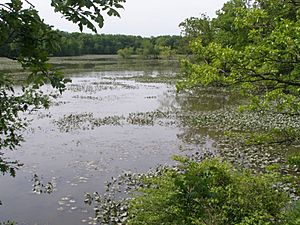Lake George (Hobart, Indiana) facts for kids
Quick facts for kids Lake George |
|
|---|---|

Lake George, Indiana
|
|
| Location | Hobart, Lake County, Indiana |
| Coordinates | 41°31′41″N 87°16′26″W / 41.52806°N 87.27389°W |
| Basin countries | United States |
| Managing agency | Hobart Parks and Recreation Department |
| Surface area | 270 acres (110 ha) |
| Max. depth | 14 ft (4.3 m) |
| Surface elevation | 604 ft (184 m) |
Lake George is a special kind of lake called a mill pond. It's located on the Deep River in Hobart, Indiana, in the United States. A mill pond is a lake created by building a dam across a river. This dam helps to power mills, which are like old factories.
Contents
How Lake George Was Formed
Lake George was created a long time ago by a person named George Earle. He built a dam on the Deep River. A dam is a barrier that holds back water. This dam helped to power his sawmills and gristmills. Sawmills cut wood, and gristmills grind grain into flour.
The lake gets its water from several small streams. The biggest stream is the Deep River itself. Another important stream is Turkey Creek.
Size and Shape of the Lake
Lake George is about 3 miles (5 kilometers) long. At its widest point, it is about 980 feet (300 meters) across. The total surface area of the lake is about 270 acres. That's like 270 football fields!
Fun Activities at Lake George
Lake George is a very popular spot for fun and relaxation in Hobart. Many people enjoy visiting the lake. Two local parks are right next to the lake. These parks offer great places to play and enjoy nature. There are also many homes built around the lake and along the Deep River.
Keeping the Lake Healthy
Over the years, a lot of sediment has built up in Lake George. Sediment is like mud, sand, and small rocks that wash into the lake. This happens especially when it rains a lot. This sediment can make the water quality worse.
In 1995, scientists from the U.S. Geological Survey studied the lake. They measured how much sediment had collected. Because of their findings, the lake was cleaned in the year 2000. This cleaning process is called dredging. During dredging, special machines remove the extra sediment from the bottom of the lake. They removed almost 600,000 cubic yards of sediment, which helped to make the lake healthier again.



